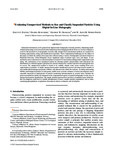Evaluating Unsupervised Methods to Size and Classify Suspended Particles Using Digital In-Line Holography
| dc.contributor.author | Davies, EJ | |
| dc.contributor.author | Buscombe, D | |
| dc.contributor.author | Graham, GW | |
| dc.contributor.author | Nimmo-Smith, Alex | |
| dc.date.accessioned | 2015-10-30T23:14:54Z | |
| dc.date.accessioned | 2015-10-30T23:19:53Z | |
| dc.date.available | 2015-10-30T23:14:54Z | |
| dc.date.available | 2015-10-30T23:19:53Z | |
| dc.date.issued | 2015-06 | |
| dc.identifier.issn | 0739-0572 | |
| dc.identifier.issn | 1520-0426 | |
| dc.identifier.uri | http://hdl.handle.net/10026.1/3758 | |
| dc.description.abstract |
<jats:title>Abstract</jats:title><jats:p>Substantial information can be gained from digital in-line holography of marine particles, eliminating depth-of-field and focusing errors associated with standard lens-based imaging methods. However, for the technique to reach its full potential in oceanographic research, fully unsupervised (automated) methods are required for focusing, segmentation, sizing, and classification of particles. These computational challenges are the subject of this paper, in which the authors draw upon data collected using a variety of holographic systems developed at Plymouth University, United Kingdom, from a significant range of particle types, sizes, and shapes. A new method for noise reduction in reconstructed planes is found to be successful in aiding particle segmentation and sizing. The performance of an automated routine for deriving particle characteristics (and subsequent size distributions) is evaluated against equivalent size metrics obtained by a trained operative measuring grain axes on screen. The unsupervised method is found to be reliable, despite some errors resulting from oversegmentation of particles. A simple unsupervised particle classification system is developed and is capable of successfully differentiating sand grains, bubbles, and diatoms from within the surfzone. Avoiding miscounting bubbles and biological particles as sand grains enables more accurate estimates of sand concentrations and is especially important in deployments of particle monitoring instrumentation in aerated water. Perhaps the greatest potential for further development in the computational aspects of particle holography is in the area of unsupervised particle classification. The simple method proposed here provides a foundation upon which further development could lead to reliable identification of more complex particle populations, such as those containing phytoplankton, zooplankton, flocculated cohesive sediments, and oil droplets.</jats:p> | |
| dc.format.extent | 1241-1256 | |
| dc.language.iso | en | |
| dc.publisher | American Meteorological Society | |
| dc.relation.replaces | http://hdl.handle.net/10026.1/3757 | |
| dc.relation.replaces | 10026.1/3757 | |
| dc.subject | Networking and Information Technology R&D (NITRD) | |
| dc.title | Evaluating Unsupervised Methods to Size and Classify Suspended Particles Using Digital In-Line Holography | |
| dc.type | journal-article | |
| dc.type | Journal Article | |
| plymouth.author-url | https://www.webofscience.com/api/gateway?GWVersion=2&SrcApp=PARTNER_APP&SrcAuth=LinksAMR&KeyUT=WOS:000356369600002&DestLinkType=FullRecord&DestApp=ALL_WOS&UsrCustomerID=11bb513d99f797142bcfeffcc58ea008 | |
| plymouth.issue | 6 | |
| plymouth.volume | 32 | |
| plymouth.publication-status | Published | |
| plymouth.journal | Journal of Atmospheric and Oceanic Technology | |
| dc.identifier.doi | 10.1175/jtech-d-14-00157.1 | |
| plymouth.organisational-group | /Plymouth | |
| plymouth.organisational-group | /Plymouth/Faculty of Science and Engineering | |
| plymouth.organisational-group | /Plymouth/Faculty of Science and Engineering/School of Biological and Marine Sciences | |
| plymouth.organisational-group | /Plymouth/PRIMaRE Publications | |
| plymouth.organisational-group | /Plymouth/REF 2021 Researchers by UoA | |
| plymouth.organisational-group | /Plymouth/REF 2021 Researchers by UoA/UoA07 Earth Systems and Environmental Sciences | |
| plymouth.organisational-group | /Plymouth/Research Groups | |
| plymouth.organisational-group | /Plymouth/Research Groups/Marine Institute | |
| plymouth.organisational-group | /Plymouth/Users by role | |
| plymouth.organisational-group | /Plymouth/Users by role/Academics | |
| dc.identifier.eissn | 1520-0426 | |
| dc.rights.embargoperiod | No embargo | |
| rioxxterms.funder | Natural Environment Research Council | |
| rioxxterms.identifier.project | Turbulence, Sediment Stratification and Altered Resuspension under Waves (TSSAR Waves) | |
| rioxxterms.versionofrecord | 10.1175/jtech-d-14-00157.1 | |
| rioxxterms.licenseref.uri | http://www.rioxx.net/licenses/all-rights-reserved | |
| rioxxterms.type | Journal Article/Review | |
| plymouth.funder | Turbulence, Sediment Stratification and Altered Resuspension under Waves (TSSAR Waves)::Natural Environment Research Council | |
| plymouth.funder | Turbulence, Sediment Stratification and Altered Resuspension under Waves (TSSAR Waves)::Natural Environment Research Council | |
| plymouth.funder | Turbulence, Sediment Stratification and Altered Resuspension under Waves (TSSAR Waves)::Natural Environment Research Council | |
| plymouth.oa-location | http://journals.ametsoc.org/doi/abs/10.1175/JTECH-D-14-00157.1 |


